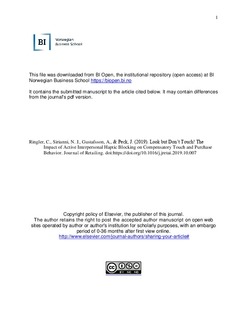Look but Don’t Touch! The Impact of Interpersonal Haptic Blocking on Compensatory Touch and Purchase Behavior
Journal article, Peer reviewed
Submitted version
Permanent lenke
http://hdl.handle.net/11250/2631454Utgivelsesdato
2019Metadata
Vis full innførselSamlinger
- Publikasjoner fra CRIStin - BI [1015]
- Scientific articles [2181]
Sammendrag
This research investigates situations in which frontline employees deliberately restrict customers’ access to touch products on display (active interpersonal haptic blocking), and how this understudied form of sensory blocking may increase customers’ downstream purchasing. While previous research examines the benefits of increased product touch, we temporarily block touch for specific products in display areas and then investigate the subsequent impact on customer behavior. Through four studies, including a retail field experiment, we find that when an employee asks a customer not to touch a product on display, this initiates a serial mediation process which: (1) engenders feelings of psychological reactance that result in (2) increased compensatory touching of subsequently encountered products to counterbalance a loss of sensory freedom, and (3) increased spending and purchasing once the customer leaves the reactance-inducing encounter. Effects are moderated by socioeconomic status (SES) and need for touch (NFT) whereby psychological reactance was significantly stronger for high SES customers with a moderate or high NFT when actively blocked. Results also demonstrate that active interpersonal haptic blocking does not result in more negative attitudes toward retailers, thus retailers might consider implementing this counterintuitive practice to encourage downstream sales.

